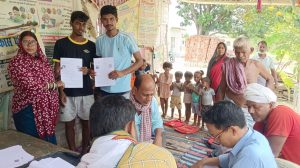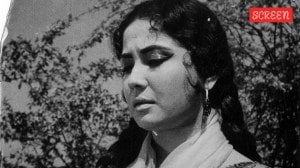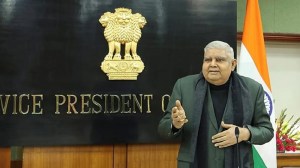Around Town | 175 years of Pancham Puriwala: Eat an array of hot puris and bhajis at Mumbai’s historic culinary gem that’s older than CSMT station
Post renovation, the eatery now has added air-conditioning on the mezzanine floor and will have dal makhani to its wide array of offerings; plans to have multiple outlets across the city.
 Pancham Puriwala was born as a small stall serving a plate with five puris, perhaps borrowing from the founder’s name Pancham that means five, with two varieties of vegetables. (Express Photo by Pradip Das)
Pancham Puriwala was born as a small stall serving a plate with five puris, perhaps borrowing from the founder’s name Pancham that means five, with two varieties of vegetables. (Express Photo by Pradip Das)Sometime in the 1840s, a young Pancham Sharma decided to leave his native place Tundla, about 30-odd kilometres from Agra’s famous Taj Mahal, and come to Mumbai. To earn his living, he decided to offer the food that was synonymous with weddings as well as religious ceremonies in North India — puris with aloo bhaji and kaddu (pumpkin) ki sabzi.
Thus born Pancham Puriwala as a small stall serving a plate with five puris, perhaps borrowing from the founder’s name Pancham that means five, with two varieties of vegetables. The guests could always ask for another serving of vegetables free of charge, a service that continues even today.
“He came all the way from Tundla to Bombay on a bullock cart,” recalled Sandeep Sharma, 61, the fifth-generation restaurateur who has been manning the eatery with his cousins – Anupam, 52, and Akshay, 50. His uncle Amarnath, who is in his 80s, also comes to the eatery once in a week out of habit.
 The eatery moved to its current location on Perin Nariman Street, right opposite CSMT station, sometime in the late 1880s or early 1890s as a small gala. (Express Photo by Pradip Das)
The eatery moved to its current location on Perin Nariman Street, right opposite CSMT station, sometime in the late 1880s or early 1890s as a small gala. (Express Photo by Pradip Das)
“Initially the stall was facing Gibbet’s Pond, also called Phansi Talao, which was used for public executions,” added his son Shivang, a hotel management graduate who represents the sixth generation to join the family business.
The eatery moved to its current location on Perin Nariman Street, right opposite CSMT station, sometime in the late 1880s or early 1890s as a small gala. The CSMT station, called Victoria Terminus previously, was built in 1887.
“It was in the 1950s that my great grandfather Badriprasad Sharma brought some shops around it and collectively it became the restaurant that you see today,” he said, while manning the busy cash counter.
Spread across 650 sqft, the 45-seater no-frill, quick-service eatery with an unassuming entrance has seen the likes of actor Nargis Dutt, Rajesh Khanna, Raj Babbar, artist M F Husain and politicians like Ashok Chavan over the years.
 The eatery, which begins service as early as 8.30 am and shuts at 11 pm, continues to be a popular choice for many who work in the neighbourhood. (Express Photo by Pradip Das)
The eatery, which begins service as early as 8.30 am and shuts at 11 pm, continues to be a popular choice for many who work in the neighbourhood. (Express Photo by Pradip Das)
“It is hearsay that Mahatma Gandhi ate here, and that Indira Gandhi would send someone to fetch a plate of puri bhaji from here but there is no way to confirm it either,” said Sandeep, who recalls that the price of a plate of puri bhaji was Rs 1.60 in the late 70s.
The eatery, which begins service as early as 8.30 am and shuts at 11 pm, continues to be a popular choice for many who work in the neighbourhood and is also on the bucket list of tourists who visit the dream city. The busiest hours are lunch hours.
“If you come at 1.30 pm, there is usually a 30-minute wait,” shared a bank employee who works in the vicinity and comes here at least once every fortnight to have Puri bhaji (Rs 60). It is the most ordered item alongside Chole Puri (Rs 80) and Pancham Thali (Rs 210). The latter is a tribute to the founder, Pancham Sharma and features five kinds of puris with paneer sabji, aloo bhaji, kadhi, a dry seasonal vegetable, masala bhindi, pulav, raita and kheer.
“We used to have only two kinds of puris — plain and bedmi puri (with urad dal mixture). In 2014-15, Rocky and Mayur (popular food bloggers Rocky Singh and Mayur Sharma), who visited Pancham, suggested we add palak puris. Subsequently, we also added beetroot and paneer masala puris,” shared Shivang, who has been the brain behind this menu expansion.
 Sandeep Sharma, 61, the fifth-generation restaurateur who has been manning the eatery with his cousins. (Express Photo by Pradip Das)
Sandeep Sharma, 61, the fifth-generation restaurateur who has been manning the eatery with his cousins. (Express Photo by Pradip Das)
Around the same time, they also added a variety of sabzis, including kadhi, matar paneer, chole as well as pulav. There is also a Pancham Royal thali (Rs 300) that additionally features three varieties of paneer sabzis. Coming up soon, revealed Shivang, is dal makhani, which is on popular demand.
The mantra for success, said the father-son duo, is God’s blessings, quality, and consistency of food. “We oversee everything,” maintained Shivang.
The eatery was shut for a little over a week earlier this month for renovation.
While it continues to retain perforated steel seats on the ground floor among other elements, cushioning has been added to the seats in the mezzanine floor, which will soon be turned into an air-conditioned space, something that Sandeep wasn’t in favour of initially.
“The outlet has gone beyond the khao-piyo-khisko style. We are also welcoming people who come from various pockets of Mumbai as well as other cities and they don’t mind paying a little extra but want comfort, especially from Mumbai’s scorching sun,” added Shivang, who has big plans for Pancham Puriwala.
“We want to have multiple outlets across the city,” he shared. Would the first one be ready in 2024? “We are hopeful,” Shivang smiled.












